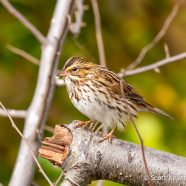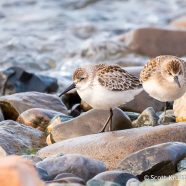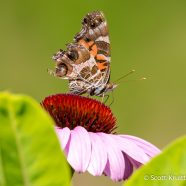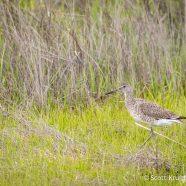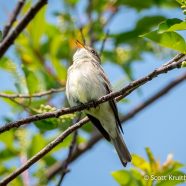Savannah Sparrow
The Savannah Sparrow (Passerculus sandwichensis) is another bird pushing south through our grasslands, fields, and farms right now. Look for their brown streaks – likely more thin and broken up than the Song Sparrow – and the distinctive yellow patch of feathers over the eye extending to their small bill.
Read MoreWestern Sandpiper (Calidris mauri)
Fall shorebirding can be very rewarding in a number of diverse habitats including farm fields, parking lots with pools of water, muddy pastures, grasslands, beaches, and rocky shorelines. Whether they are foraging, preening, or roosting there are always good chances to examine shorebirds for prolonged periods. That does not mean the task of identifying them will be easy! For every readily identifiable bird like the American Oystercatcher there seem to be a few difficult to discern species. The juvenile Western Sandpiper (Calidris mauri), as seen below and photographed in late August, can be...
Read MoreTattered Lady
The American Painted Lady (Vanessa virginiensis) is best identified when nectaring like this by the two large eyespots on the ventral hindwing. The very similar Painted Lady (Vanessa cardui) would have four smaller eyespots in the same place. This individual is tattered and torn, experiencing some wear and tear after being busy on the wing for probably only a couple weeks, or a few at most. Adult life spans are short for many of our butterflies, and they have a lot to get done in such a small window, which makes it all the more important to have plentiful, widespread and organic food...
Read MoreWillet
Here is a Willet (Tringa semipalmata) that I photographed during the Noble Proctor BioBlitz Challenge this past May. Now that we have entered August we are firmly in the time of year for these birds to be found as migrants in many marshes, wetlands, beaches and coastal locations. We can also expect to find one or two Western Willets that have a distinctly different appearance including a softer toned, less-barred gray body, a slightly leaner bill, and a bit of a larger overall size. See if you can spot one soon! That can be a difficult task to begin with as you can see how well their...
Read MoreEastern Wood-Pewee
I recently mentioned that we still have flycatchers coming into the region as spring migration wraps up, and even into early June you may find individuals at migratory stopover sites. One such bird was this Eastern Wood-Pewee (Contopus viren), and he provided far better looks here than most do in the depths of the dark forest or higher up in the canopy. Finding him was easy thanks to that “peeeeaaaweeee” call, and he is belting it out in the second photo. Identifying flycatchers by voice makes life so much easier, especially when you cannot always rely on habitat thanks to...
Read More



